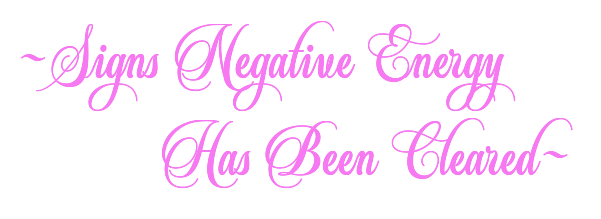Negative Energy & Cleansing Negative Energy

The world is full of aggressors that impact our well-being and psyche. These aggressors include pollutants, noise, negative energy, stress, and toxic people who project their pain outwards onto others. When you are an empathetic person, this can cause difficulties because you are naturally conscious of the feelings and auras of others and the environments that surround you.
While we may not have the technology to measure it, you likely know how negative energy feels. Negative energy is a force that is destructive and serves to leech energy from our energetic resources. It creates conflict and resentment. Negative energy can leave you exhausted both mentally and physically. Negative energy perpetuates itself, therefore, breeding more negativity. Learning to deal with negative energy is essential for your health and happiness.
Negative energy tends to come from three sources, negative people, negative environments, and negative self-talk.


Negative energy can be so ingrained in people that they do not even realize that they exude negativity. Negative people are judgmental, insecure, and generally dissatisfied complainers. They often degrade others and frequently have a doom and gloom attitude. Negative people survive on an unhealthy diet of constant worry. Negative people also are continually in the business of others, telling them what to do or think. Conversation with negative people is often tedious as they tend to be quite secretive and reactive. Fearful of revealing too much information about themselves, these people are overly concerned that anything told will be used against them somehow. Negative people rarely envisage a positive outcome or a great result. They also tend to submerge themselves in bad news reported by the media. Research has shown that media exposure to violence, death, and tragedy contributes to depression and anxiety as well as to post-traumatic stress disorder. It colors a person’s outlook on life. Negative people tend to be overly sensitive to criticism, even taking compliments the wrong way. You will rarely find a negative person outside of their comfort zone. Negative people tend to be underachievers who do not get excited about future projects. The more negativity is bred, the more likely a negative person is to become an energy vampire.

You intuitively feel insecure, unhappy, and tense around negative people. Their energy is uninviting and off-putting. Those who emanate negative energy often consider all of the worst-case scenarios. Negative people frequently only view their perspective and every comment they hear passes through a mental filter in which they ask themselves, “What does that say about me?” Social media can stress out negative people who often view things in extremes and assume that others are enjoying life more than they are. Negative people tend to fail to follow through on projects; when things become difficult or require more effort than they’d initially thought, they will abandon the project. Negative thinking leads the person to focus on unpleasant aspects of a long-term project rather than on the satisfaction derived from completing the project.

Negative people also believe that they are too old for everything, relinquishing possibilities out of fear. Those who emanate negativity tend to live in the past, limiting options instead of opening their minds to their possibilities. Negative people will negatively deal with positive things. When negative people encounter something positive, they become anxious, fearing that it is temporary. As a result, they focus on what is wrong with the good thing, poking holes in the positivity, so they are not disappointed when/if it goes away. Additionally, negative people frequently pick fights with others, including their partners. If you are a person who speaks more negativity than positivity to the people in your life, you are likely a negative person.

Never and always are the favorite words of the negative person. Negative people have a habit of seeing the world in all-or-nothing terms. When a person sees the world or their circumstances in terms of absolutes, it leaves little to no room for exceptions. Negative people would rather not try a task than fail at it. Fear is typically the root cause of this refusal to try anything new or different to bring positive change.

Negative people are often jealous and controlling. They also tend to be so firmly stuck in a daily routine that any deviation from their routine makes them highly uncomfortable and anxiety-riddled. Negative people are frequently inflexible when it comes to unknown situations. Someone who regularly thinks negatively will take the anger of others personally. Negative people tend to exaggerate their mistakes, often judging themselves harshly. Negative thinking can create impediments in social interactions, making it difficult for a negative person to open up and engage with acquaintances they just met or even colleagues they've known for years. This is often due to a lack of confidence or an over-seriousness that makes it hard to enjoy light, substance-free banter.

Negative and polluting forces can have various backgrounds and intents. Many physical symptoms can accompany harboring negative energy in the body. These symptoms include, but are not limited to, restlessness, sleepiness, nervousness, headaches, stomach aches, fatigue and exhaustion, heavy breathing, confusion and tension, sudden mood swings, and anxiety or depression.


Spiritual research has revealed that most houses worldwide have some form of negative vibrations. These negative vibrations can be due to many reasons, such as the people in the premises, whether they are doing spiritual practice, what type of spiritual practice they are doing, and the psychological profile of the residents. Negative energy in a physical place can also be due to the purpose of the premises. It can be caused by the structure’s construction type, the house’s cleanliness, the items in the house, and their placement. Negative energy can accumulate because of what was done on the land on which the house was built. Lastly, negative energy in a dwelling can be caused by the surrounding area.

Negative environments leave you feeling uncomfortable and looking for the nearest door through which to escape. Negative emotions, arguments, illness, and even stagnant air can produce negative vibrations that linger in an environment. Environments can also hold on to the energy of people who live or once lived there. Even physical details of your surroundings can impact your mood and energy. Clutter, for example, can create stress and even interfere with your sleep. Bad vibes don’t dissipate over time and can attract—and perpetuate—similar negative patterns in the future. I also believe that the Earth can hold negative energy. Negativity builds up on land in many ways. For example, human discord of any kind settles on the land where the conflict occurs. This conflict can be anywhere on the spectrum, from a simple argument to wars killing thousands or hundreds of thousands of people. Even the most pristine piece of land, uninhabited by humans, will have negativity delivered to it by wind and precipitation. For example, rain clears the atmosphere of negativity but leaves this negativity on the land. The negative energy will remain upon the land until humans cleanse it through energy work or until nature cleanses it through hurricanes, thunderstorms, fires, droughts, floods, high winds, etc. Negative emotions tend to be denser and remain longer than positive ones if not consciously cleared out. It is essential to clear energies left in homes and on land from past or present pain and suffering.

Importantly, negative energy in an environment can attract darker energies. Many signs indicate that your home or a building has accrued negative energy. The first is that you feel tense and unable to relax in a particular space. Without a designated relaxing area, you’re likely to feel more stressed, anxious, and tired. Over time this may morph into physical symptoms such as stomach aches and headaches, so a great place to relax is essential. You should try to keep your relaxing space as clean and clutter-free as possible. A messy room is stressful because you will constantly look at the dirt or clutter and think about cleaning it rather than focusing on your relaxing activity. Also, cluttered spaces tend to be chaotic and disorganized, leading you to avoid the space altogether. It can be beneficial to make it part of your relaxation ritual that you quickly clear away any mess before you settle down. Keeping on top of things daily means that tidying up your space takes minutes and not hours, giving you more time to rest and relax. When creating an area to relax, you should be careful of your choice of colors. Color choice is very individual-specific. As a general rule of thumb, it is best to avoid bright, over-stimulating colors and instead opt for more muted tones for relaxation space. Pick colors that bring you joy. Many people find blue a relaxing color, but this is not always the case. I personally like earth tones, so my house is filled with gray, tan, green, and burnt orange tones. My house also tends to be dark because most of the windows are on the front of the house, lending little but artificial light to the back of the house. I find that lighter, brighter colors in these rooms give them a more uplifting feel. Experiment with what works for you. Many stores offer small paint sample jars for just a few dollars. Paint swatches on your wall and live with them for a week before making your final decision. Once you have sorted out the visuals of your space, you next want to consider the other senses. Firstly, let’s think about touch. If your chosen chair, sofa, or bed has worn springs or feels as hard as a church pew, then it is no wonder you can’t relax. The same is true for texture. If your sheets are coarse or your sofa is made from itchy material, then settling down isn’t going to be comfortable. Instead, try laying a soft blanket over your sofa, as this will be much comfier, and invest in a quality mattress when your time and budget allow. Scent is another factor that can impact your relaxation. No one wants to try to relax in a space that smells of stale food or stinky socks. Try lighting incense or a candle in your relaxation space, or use essential oils to surround yourself with a smell that you find calming. Lavender and clary sage are great for reducing anxiety and smell fantastic too. Lastly, turn your attention to the noise in your space. I find the ticking of a clock to be annoying and also stressful. It makes me aware that time is passing, and I feel my time of relaxation ticking to an end with each tick. I also cannot stand the plinking of a leaky faucet. Whatever it is, try to remove irritating sources of noise from your calming space so there is no distraction between you and enjoying whatever it is that makes you feel relaxed.

The second tell-tale sign that your space has accumulated negative energy is that you feel unfocused or unmotivated in your space. Some spaces in your home are designated for productivity, such as an office, studio, or kitchen. However, it can be hard to focus on the task at hand with negative energy in your space. You may find your productivity within that space drops or that you are reluctant to instigate activity in the space in general. Similar to the point above, limiting clutter in your workspace is crucial. Clutter creates a visual distraction leading to overstimulation, making it harder to focus on your project. Even if your space is tidy, you should ideally avoid having anything that is highly patterned, features text, or vivid imagery within the eye line of your workspace. The eye will naturally be drawn away from your project and to the visual distraction regularly as you work, even if you don’t realize this is happening. Put any sheets, pens, or notebooks away to avoid mess at the end of each day. A cluttered space leads to chaotic thoughts, so if you find yourself a regular sufferer of brain fog while working, you likely have some negative energy that needs clearing in your workroom. In a workspace, it is vital to avoid strong scents. Strong scents can be great for a relaxation space, but they can become distracting and lead to headaches and clouded thoughts when working. Make sure you air your workspace regularly. A stuffy, confined space can be a breeding ground for negative energy, allowing it to build up and infuse your room. Opening a window will let much-needed fresh air in and will clear the negative energy from your room.

A third way to know your space is harboring negative energy is that you feel anxious, restless, overwhelmed, or generally stressed in your space. Have you ever had a time when you dreaded coming home? Or dreaded entering a particular room or space? These feelings are usually a buildup of negative energy that is overwhelming to face. In addition to paying attention to your space, you must pay attention to the objects within your space. One of the largest draws of negative energy within the home are second-hand or antique objects. It is important to cleanse these objects when they enter your home. Things can hold onto their history and the energy placed within them from previous owners. The energy signature can then fill your space with negative energy, or energy that is foreign to your home, causing things to be off-balance. To help clear negative energy from objects, there are several things you can do. If you can physically wash the item, this is often the simplest way to thoroughly cleanse the object of stagnant energies as well as dirt, dust, and grime. Washing the object also allows you time to connect with and appreciate the object, giving the item more meaning when placed in your home. Quickly repairing broken items will also keep negative energy at a minimum. Regularly being confronted with broken objects in your space can make you feel restless and anxious.

Similarly, if you feel generally uninspired in your space, it is likely holding on to negative energy. You should always make sure that your home is as inspiring and spiritually nourishing as possible. This will help you view your home in a positive light consistently and will help show negative energy to the door. Rearranging furniture can be a great way to increase the positive energy in a space. This makes it easier to navigate your room and allows you to claim ownership of your space. Your space should also be filled with things that bring you joy.

Lastly, a classic sign of negative energy flowing through your space is the inability to sleep or not feeling rested after sleeping. The area you sleep in needs to be carefully curated. Just like when trying to focus in your workspace, you should remove anything over-stimulating from view when you rest in your bed. This includes telephones and televisions. You should also avoid any strong scents in your sleep space. Avoid over-stimulating sounds if possible and remove anything that ticks from your space. Focusing on the ticking of a clock when trying to sleep is only likely to leave you frustrated, as it will remind you of how long it is taking you to settle. In the morning, be sure to take the time to fluff your pillows and shake out your sheets before making your bed. Airing out your bedding helps remove any negative energy that has been stagnating. Making your bed has the benefit of mentally preparing you for the day ahead and is a great time to sneak in some mindfulness. Also, a freshly made bed helps make your bedroom look far neater and more inviting. This means if your bedroom is also a place where you work, you’ll be able to focus better. If it is a place of creativity, ideas should start to flourish, and if it’s your place to relax, you should find that when the day comes to an end, you settle into a restful sleep much more quickly.


We’ve all heard that voice in our heads — the one that can ruminate on mistakes or replay cringe-worthy events. Sometimes, it can be downright rude or unkind, with harsh criticism and judgments about our work, appearance, or personality. Our mental chatter is what psychologists call self-talk.

Throughout the day, we have a running dialogue in our heads that can range from talking ourselves through how to carry out a task to making observations about our internal or external environment and situation. In recent years, self-talk has become among the most discussed topics in psychology, with researchers honing their self-talk definition. Studies suggest that how we speak to ourselves has a powerful impact on our mental and physical health, including weight control, managing stress, and improving sports and academic performance.

Negative self-talk is the flow of primarily unspoken, negative thoughts that run through your head. Unfortunately, this inner dialogue tends to arrive with a negative bias, and if we give this chatter too much influence, it can impact our confidence, self-esteem, and productivity. These are often illogical thoughts or painful ideas that have no basis in reality. Negative thoughts can sink our mood and perpetuate a sense of helplessness and hopelessness. They can lead to everything from lost opportunities to depression.

Negative self-talk can take the form of pessimism, dwelling on bad things that have happened, personalizing, filtering, catastrophizing, negative self-labeling, should statements, and all-or-nothing thinking. Personalizing is when, if something negative occurs, you automatically blame yourself. The first step to combat this thinking is to do some reality testing. Challenge yourself by asking questions such as “is there any evidence to support this thought?” or “is the thought factual or just my interpretation?” Next, think of an alternative explanation to counteract the negative thought. Filtering occurs when you magnify the negative aspects of a situation and filter out all positive ones. No matter if they are big or small, every accomplishment can outweigh the negative. Life will feel so much more rewarding when you begin to look at the glass as half full instead of half empty. If you find yourself filtering, try to jot down all the things that have gone right recently. You’ll slowly begin to realize that things may not be as bad as they seem. When you are catastrophizing, you automatically anticipate the worst. It is essential to keep things in perspective by asking yourself, “what is the likelihood this horrid event I just thought up might occur?” Also asking yourself, “if the worst-case scenario does occur, will I still be ok?” can help counter negative thinking.

The Harvard University Stress and Development Lab identifies ten types of negative self-talk we can experience, such as “all-or-nothing thinking” or “jumping to conclusions.” By identifying when we fall into one of these traps, they say we can reappraise whether these interpretations of our situation are helpful to living our most fulfilling life. Perhaps their most pertinent example of defining what is negative self-talk is what is known as “emotional reasoning,” where we assume our negative emotions reflect the way things really are, or, “I feel it; therefore, it must be true.” Our thoughts and feelings are just that, thoughts and feelings, and they do not need to dictate our moods or behavior.

Negative thoughts can harm your health and well-being. Being a positive thinker doesn’t mean that you ignore problems. Instead, being a positive thinker can better your ability to deal with issues as they arise.

Even the most successful and happiest people experience some negative self-talk. But these loud thoughts — coming from our inner voice — are not the issue; it’s the weight we give them, how we choose to engage with them, and the storylines we create around them that get in our way. But if there is no “off” switch to our ruminating, the question is ‘How to combat negative self-talk?’ Ultimately, we are the ones in control of this inner voice, even if it sometimes doesn’t feel that way. But one effective tool to prove the truth of this is meditation.

Much of the advice around overcoming our inner-critic focuses on stopping negative self-talk by replacing it with a more positive inner dialogue. But true self-esteem comes from changing our relationship with our thoughts rather than overriding negative thoughts with more positive ones. Remember, thoughts are just thoughts, neither negative nor positive. We are the ones adding the extra layer of meaning or the labels. When working out how to combat negative self-talk, we should understand that thoughts and feelings that fuel our inner dialogue are neither good nor bad. Happiness is just happiness. Sadness is just sadness. It is the storylines we create around our thoughts and feelings that can cause issues.

Rather than trying to learn how to stop self-talk altogether, we should listen, be curious, acknowledge these thoughts without judgment, and let them go. This involves not being too hard on ourselves and treating our fears and concerns similarly to if we were giving advice to a friend or loved one — with compassion, kindness, and understanding.

Psychotherapist Kate McCauley, M.Ed., LCSW, says: “The only road to true mental health is self-compassion. Without it, you enter the world from a defensive perspective, protecting yourself from your inner self-critic.” One of the goals of meditation is to let go of self-judgment and create a softer, more gentle mind where kindness can thrive.

Self-compassion is comprised of three components: being kind to ourselves as we make mistakes (self-kindness), recognizing that suffering is part of the human experience and felt by everyone (common humanity), and observing our emotions and thoughts in a non-judgmental manner (mindfulness). For many people, the most challenging person to direct kindness to is ourselves. Techniques such as noting allow us to gently acknowledge our thoughts and feelings as they arise without judgment, which gives us the power to let them go.

Combating negative self-talk takes practice. It is vital to incorporate positivity whether you’re experiencing challenging moments or not. An excellent way to do this is to begin your day with positive affirmations. Practicing positivity isn’t about disregarding the unfortunate nature of a situation but acknowledging that you will find a way around it.


Everything is made of energy, and it’s extremely simple for that energy to build up and bring you down. You’re likely already clearing your home of physical clutter—so why not tend to its energetic clutter? It is equally important to cleanse your mind and body regularly of any accumulated negative energy. We have already discussed, at length, the detrimental physical and mental effects of harboring negative energy in your space, in your mind, and your body.
Getting in the habit of removing the negative, chaotic energy surrounding you could make your space feel lighter, brighter, and more creative. There are many times when it is important to cleanse yourself and your space of negative energy. Some of these are when you are having a bad day, when you’ve been sick, after a breakup or loss of any type, after an argument with those in your home, during any major life transition, and when you are feeling stuck.

One of the most challenging but most effective ways to cleanse negative energy from your life is to retrain your brain to think in a positive framework. Journaling negative emotions will help raise your awareness of them and allow you to quickly identify patterns of negative thinking. Breath work is also an excellent method to cleanse negative energy. Breath work can be done by bringing your attention to the breath, counting breaths, belly breathing, box breathing, or alternate nostril breathing. Several of these methods are self-explanatory. I will describe the less known methods next.

Box breathing serves to slow the sympathetic stress response. To practice box breathing, set a timer for five minutes and then sit with a straight spine, either on the floor or in a chair. Next, close your eyes and inhale for a count of four, then hold for a count of four, then exhale for a count of four, and finish by holding the breath out for another count of four. To practice alternate nostril breathing:
✤ Start with the palm of your right hand facing you.
✤ Fold down just the middle and pointer fingers, keeping the rest extended.
✤ Press your right thumb against your right nostril, closing it.
✤ Inhale slowly through the left nostril.
✤ Lightly press your left nostril with your ring and little fingers so that both nostrils are briefly closed simultaneously.
✤ Release pressure on your right nostril while holding the left, and inhale through the right nostril.
This breathing exercise helps slow breathing and balance your brain hemispheres. With regular practice, alternate nostril breathing can balance your nervous system and lessen your stress response.

An excellent way to prevent negative energy from polluting your positive energy is to detach from the energy that is not yours. Setting healthy boundaries is a crucial way to steer clear of situations that could provoke negative feelings internally or put you in the presence of them from other people. If you set internal energetic boundaries, you will avoid processing other peoples’ negative vibes. You will be able to identify which energy is yours and which energy you have taken on from another person. Permit yourself to release all energy that is not yours.

Because it’s is a powerful cleansing agent, you can readily incorporate water into your restorative self-care practices. Taking a bath is a good way of clearing stagnant energy. Bathing is a perfect way to purify the aura of negative energy and re-nourish your spirit. Adding in some essential oils such as eucalyptus, cedarwood, and lavender, along with some Epsom or sea salt, works to calm the body, mind, and spirit. Additionally, being in a body of water such as a river, lake, stream, or pool allows you to be more present with yourself. As you bathe, think about what energy you need to release and let the worries and negativity wash away as the bathwater drains.

Practicing chakra balancing meditation is also a fantastic way to cleanse the body of negative energy. You can find some great chakra balancing guided meditations on YouTube if you are just beginning this type of meditation. Below is a brief summation if you are not familiar with the chakras. Visualize your chakras as wheels of energy or vortices located along your spine, ranging from the lowermost part of your tail bone to the very top of your head. The red root chakra is located at the base of the spine, at the end of your tailbone. The orange sacral chakra is located in the pelvic area. The solar plexus chakra is represented by the color yellow and is situated in the stomach, right above the belly button. The green heart chakra is at the center of the heart. The color blue represents the throat chakra, which is found at the front of the neck just above where your collar bones meet. The indigo third-eye chakra is located at the center of your forehead. Lastly, the crown chakra is white and is located right above the top of your scalp. Bring these different colors and placements to your mind, and breathe into each one, permitting yourself to expand the energy with your breath. You can also incorporate crystals that correspond with the colors of the seven main chakras. Crystals can be placed over the corresponding chakra, worn as jewelry, put in bath water (as long as the crystal can get wet), kept in a pocket, or slid under a pillow at bedtime. Crystals such as garnet, ruby, black tourmaline, or black onyx are excellent for the root chakra. I also use red jasper a lot in root chakra meditations. Carnelian, citrine, sunstone, fire opal, orange calcite, and moonstone are all beautiful crystals that will aid in the opening, balancing, and tuning of your sacral chakra. For harmonizing the solar plexus chakra, you can use yellow stones such as yellow jasper, amber, golden topaz, and tiger’s eye. I also use citrine for meditation on the third chakra. Since the heart chakra is represented by both the colors pink and green, you may use both colors of crystals for this chakra. Jade, rose quartz, peridot, green aventurine, and ruby in fuchsite are some of my favorite heart chakra stones. Sodalite, turquoise, lapis lazuli, aquamarine, blue onyx, and larimar are all excellent throat chakra stones. I am drawn to blue crystals, so I have a wide array of different blue crystals that I can use for meditating on the throat chakra. For the third-eye chakra, indigo stones can be used. I have difficulty identifying indigo because the color is a deep bluish-purple to me. Common stones used for this chakra are amethyst, purple fluorite, and blue chalcedony. I prefer to use amethyst for the crown chakra, so I typically use iolite for the third-eye chakra. For the crown chakra, labradorite, aura quartz, clear quartz, diamond, and amethyst can be used. If you do not have diamonds readily available, you can use Herkimer diamonds, which are much more affordable, instead. Herkimer Diamonds are the most powerful of all quartz crystals. Being doubly terminated, they can transmit their own energies and receive spiritual energy, amplify it, and focus it intently. They are also the hardest and most durable quartz crystals. In summary, as long as the crystal’s color corresponds to the chakra’s color, feel free to use whatever stone speaks to you on a personal level. If you do not have a particular color of crystal, you can do a little shopping or substitute any white, clear, or black crystal.

Incorporating short mindfulness moments throughout your day will help to keep your energy positive and will assist you in alleviating feelings of being overwhelmed. Throughout the day, take a moment to pause, feel your feet as they connect to the ground, place your hand on your belly, and take three deep breaths. I will also grab my favorite crystal, hold it in my hand, and focus on its properties. Is it heavy? Is it smooth? Is it cool to the touch? Visualize its beautiful, rich color in your mind. Imagine it absorbing all of the negative energy in and around your body. This is one of my favorite ways to experience a mindfulness moment because it is quick, and I can do it anywhere. It also gives me an excellent excuse to play with my rocks! Mindfulness can help you release negative thoughts by helping you engage with the present moment, one in which the anxieties or worries of tomorrow (or maybe even five minutes from the present moment) don’t exist.

Spending time in nature will also help you banish negative energy from your body. The Earth is one of the most powerful (and free) energy healers that we have. Allowing yourself to be supported by the Earth can be deeply restorative. Most nature spots are full of negative ions, which, contrary to their name, actually help us with creating positive energy. Spending time near the ocean is also a powerful way to cleanse negative energy. Whether you’re swimming or dipping your toes in the water or simply breathing in the salty air and listening to the sounds of the waves, you’ll find that it’s a powerful way to bring your energy into equilibrium and feel more centered as a result. If you are limited geographically from visiting that perfect forest or walking along a sandy beach, simply stepping outside to get vitamin D from the sun can help you center yourself and release negative energy.

Practicing visualization is a powerful way to cleanse and protect yourself from negative energy. There are many ways to practice visualization that are as unique as you are. I use several different visualizations regularly. When I am returning to my home, before entering it, I imagine myself being surrounded and protected in a beautiful warm light that holds all the wisdom, sweetness, and love from God. I visualize my entire body filling up with this light and every cell being bathed in it. I imagine this light surrounding me like a warm, safe cocoon. Once I have eliminated any negative energy and prepared my mind, I will enter my home. You can also visualize yourself with healing energy pouring from above your head and traveling along your spine throughout your body, reaching the most remote locations of your body, such as your fingertips and toes. Bubble visualizations are also a popular method of protecting yourself from absorbing negative energy. To begin, visualize a bubble formed around you, starting at the top of your head and wrapping around your feet. Visualize this bubble filling with bright, protective, and loving white light. As the bubble fills with light, set the intention that you can release energy out through the shield, but nothing can penetrate it unless it serves your highest good. As you interact with people throughout your day, visualize peoples’ negativity bouncing off your shield, leaving you unaffected.

Since I am a Christian, I always say a brief armor of God prayer before leaving my home. I adapt this prayer from Ephesians 6:10-18. The armor of God represents the defense we must take in our spiritual lives. The Bible tells us that we are fighting a war against Satan, who seeks to destroy us. Therefore, we must take action and put on God’s armor. As I pray this prayer, I imagine putting on each piece of God’s armor. My prayer is below:
"Dear God, I put on your full armor to guard my life against attack today. I put on the belt of truth to protect against lies and deception. I put on the breastplate of righteousness to protect my heart from the temptations I battle. I put the gospel of peace on my feet, so I am ready to take your light wherever you send me this day. I choose to walk in the peace and freedom of your Spirit and not be overcome with fear and anxious thoughts. I take up your shield of faith that will extinguish all the darts and threats hurled my way by the enemy. I believe in your power to protect me and choose to trust in you. I put on the helmet of salvation, which covers my mind and thoughts, reminding me that I am your child, forgiven, set free, saved by the grace of Christ Jesus. I take up the sword of the Spirit, your very Word, the one offensive weapon given to me for battle, which has the power to demolish strongholds, alive, active, and sharper than any double-edged sword. I ask for your help in remembering to put on your full armor every day, for you give me all that I need to stand firm in this world. Forgive me, God, for the times I’ve been unprepared, too busy to care, or trying to fight and wrestle in my own strength. Thank you that I never fight alone. Thank you for constantly being at work on my behalf, shielding, protecting, strengthening, exposing deeds of darkness, bringing to light what needs to be known, covering me from the cruel attacks I face even when I am unaware. In the mighty name of Jesus, Amen."

Using positive affirmations is also an excellent method for cleansing your body of negative energy. The key is to say affirmations that are in the present tense, such as “I am at ease,” “I am beautiful,” or “I am strong.” Make sure that these affirmations do not have any hidden negative words such as “I am no longer afraid.”

Limiting complaining is another excellent way to cleanse negative energy and keep positive energy flowing freely. Make a mental note of the number of times you complain in a day. When you do so, you will realize that whining and complaining are unnecessary most of the time. Complaining also includes unspoken, mental whining. The more you talk about or think about what is irritating you, the more you pay attention to it. This thought process opens you up to attracting negative energy. If you have a genuine problem, focus on finding a positive solution.

Smudging is a wonderful way to cleanse both the body and an environment of negative energy. I believe smudging to be so vital to clearing negative energy I have decided to create a page dedicated to this ancient ritual. Smudging is an ancient purification ritual practiced originally by Native Americans. It involves igniting a bundle or braid of dried herbs and gently directing the smoke to purify people or spaces. Smudging combines the power of plant energy with our energy. This combination is potent and can accomplish amazing things. Smudging renews and cleanses the body, mind, and Spirit. Smudging creates a “cleansing” smoke bath that purifies the physical and spiritual body bringing harmony and emotional balance. The smoke acts as our soap, and our focused mind works as the water. Together they have the power to cleanse us of negativity and return energy to a neutral state. Smudging releases negative ions, which research shows create a more positive environment by fostering spiritual cleansing and connectedness with the spiritual realm. Burning herbs releases scents and vibrations into the air, replacing negative energies with the healing properties of herbs from the Earth. Smudging is a natural antidepressant as the positive ions in our environments have been linked to depression, sadness, and low serotonin levels. Negative ions produced travel to our bloodstream from inhalation. This lowers blood pressure, relieves stress, normalizes breathing, and improves sleep.
In smudging, the plant we choose is important, but equally so is our contribution. We cannot rely on the plant to do it all. We need to come to the smudging session with our minds in the proper mindset. Set your goal or intention for what you would like to achieve during your smudging session. During the session, it can be helpful to repeat a mantra or prayer to focus on the task at hand. Our minds are powerful. Do not focus on the bad vibes that you want to release, but instead focus on the result, a peaceful and neutral living space. Countless plants can be used for burning purposes, each with different properties. I will list a few here for your reference: blue desert sage, cedar, juniper, lavender, mugwort, palo santo, sweetgrass braid, white sage, and yerba santa. The properties of each are discussed in-depth on the smudging page.
Smudging does not have to involve a complicated ritual to be effective. Just light the end of your stick and allow it to smolder with an abalone shell or a heat-proof bowl underneath to catch embers. Guide the smoke toward and around you from head to toe. Don’t forget your back and under your feet. You can use your hand or a feather to guide the smoke around your body. Throughout the smudging process, focus your intention on the matter at hand. Feel free to state your intention to cleanse your body and mind aloud or silently. This can also help to keep your mind focused.

As you can see, there are many ways to cleanse your body and mind of negative energy. The above are just some examples to help you get started. You can adapt any of these methods to fit your belief system. You can also create your own strategies for cleansing negative energy. I’d love to hear what approaches you have tried, which methods worked best for you, and if you have created any techniques of your own.

Your home should be your safe haven — the place where you feel relaxed, happy, and at peace. But when bad energy is lingering around, your home can quickly become the complete opposite; it can become a place of hostility and negativity. When you have this negative energy in your home, it can affect every other aspect of your life. That’s why house cleansing is an integral part of your well-being.

Knowing how to detect negative energy in your house can be quite simple. You can tell whether the energy in your home is good or bad – or neutral – based on the way you feel while you’re inside the home. A house filled with good energy feels fresh and vibrant; it’s full of life and you feel good being there. Some may say it has good qi or feng shui. On the other end of the spectrum, a home drowning in bad energy will make you feel like you’re being stifled, smothered, or even crushed. You can feel the tension in the air and there are a thousand places you’d rather be. Negative energy and stress go hand-in-hand, so if you’re constantly frazzled or at the end of your rope, your home could be partly to blame.

There are some tell-tale signs that your house might be brimming with negative energy. If you or your family members catch yourselves complaining, even when things are okay (or worse, when they’re pretty good), you may have negative energy in your home. The same is true if you’re struggling to find positivity in life. Negative relationships may also indicate a build-up of negative household energy. When the people around you – spouses, children, family, roommates, and friends – are negative, it’s worth taking a look at the kind of energy you’re radiating. Negative energy attracts more negative energy and it becomes a vicious cycle. Another sign of negativity in the home is if residents fail to take responsibility for their actions. Negative energy in the home could be preventing them (and you) from looking inward to place responsibility where it belongs. If there are many critical people within the home, your home could be swamped with bad energy. When you or others in your house send out negative vibrations, you’re increasing the bad energy in your home. One of the most prominent signs of negative energy in a home is clutter. Clutter blocks the way energy flows through a home, so it could be keeping bad energy in and making things worse. These are all reasons why regular house cleansing should be a part of your routine.

The first way to cleanse your home of negative energy is to declutter. Clean your tabletops, closets, and workstation to free up space and invite positivity. A cluttered home or space creates chaos and disorder; both are negative energy breeders. Once you have decluttered, make sure not to let the clutter creep back in. I know I am starting to accumulate clutter when I have unopened mail and unread magazines or newspapers. Those things signify that my space is beginning to get out of control. Also, make sure not to hoard items that you no longer need. If you do not have the space to put something away out of view, it is probably clutter that needs to go. Find a local charity or Goodwill store and donate your unused items. Not only will you receive a benefit (a tax deduction), you will help keep your home in order. While cleaning your home, make sure to clean every corner. Open all the blinds and, weather-permitting, open your windows. Let in as much light and fresh air as you can while cleaning. I often place a fan opposite an open window to help create circulation and circulate that negative energy right out the door! Don’t forget to dust, vacuum, and check for cobwebs – you don’t want the negative energy to have any reason to stick around.

As you clean your home, dispose of any broken items that cannot be repaired. Feng shui traditions warn against keeping broken things in your home as they represent both internal and external clutter that has no place in your life. A broken clock, in particular, can be a bad omen. You should also rid yourself of items that do not bring you joy.

When you’ve cleared away the clutter and removed broken items from your home, you are then free to clean your house thoroughly. You can use the following recipe to make a negativity banishing house cleansing solution. You’ll need the following for this house cleansing solution:
✤ Five lemons
✤ ¼ c. ammonia or white vinegar
✤ Sage, frankincense, or copal (or all three)
✤ A fireproof dish for catching embers and ash
✤ Sea salt
✤ A bell
✤ Selenite

Simmer lemon peels in water and let the steam scent your space. You can also put this tincture into a spray bottle and spray it throughout the house. Be careful to avoid fabrics that are not colorfast. You can also leave small dishes containing lemon slices throughout your home. Not only will your home smell fresh and bright, but the lemons will also help to dispel lingering negative energy.

Another quick negative energy ridding solution from your kitchen is to take two tablespoons of white vinegar, two teaspoons of granulated salt, and 500 ml of clear water, pouring the white vinegar into a clear glass jar. Add water and granulated salt to the jar and mix slowly. Stir well for 40-50 seconds and allow to solution to rest. Then, place in the room or area where you think the negative energies originate. If you cannot identify the source of the negative energy, you can place similar jars in other rooms throughout the home. Keep the jar open in the area for a day. After one day, observe the salt granules. If the salt settled at the bottom of the jar, negative energies have been trapped, and the room or area is now cleansed. If the room has no negative energy, the salt will rise and float in the water. Next, take the jar outside the house and empty the water in the soil. Do not discard this water inside the house. I make sure to discard the water as far away from my residence as possible.

Salt can be used in numerous ways throughout your home to rid it of negative energy. You can dissolve sea salt in a spray bottle filled with water and mist the air of every room. Also, you can place a thin line of sea salt in front of your home’s entrance or around the perimeter of your property. Incidentally, this will also kill weeds and grass. We have done this as a negativity banisher/weed control every spring for several years now. You can strategically place small bowls of salt throughout your home or dissolve salt in water used to clean surfaces and floors. Please make sure the salt is thoroughly dissolved so it does not scratch any flooring that might be delicate. Another simple way to incorporate salt is to utilize Himalayan salt lamps.

It is a good idea to begin house cleansing with doors and windows. The doors and windows are where outside energy enters your home. Keep them purified by mixing a bucket of water with the juice from five lemons, one cup of sea salt, and ¼ cup of ammonia or white vinegar (see solution ingredients listed above). Clean the doorknobs, doors, door frames, and windows in your home with the solution to keep them purified.

Another great way to extricate negativity from your home is to set a new intention for your space. Remember that form follows thought. Setting an intention is activating a part of your receptivity. If you were to go out in the day and not have set any purpose or created any prayer or manifestation of how you want the day to go, then you’re getting on a bike with no direction. This is why it is crucial to set a specific intention for your home early in the cleansing process. As you cleanse, remember that intention. What do you want your space to help you release? How do you want your home to feel? Speak your intention out loud to set the energy shift in motion. Some examples follow:
✤ “I intend to cleanse negative energy from my home, so I am focused and productive.”
✤ “I intend to cleanse negative energy from my space to achieve a peaceful setting for my mental well-being.”
✤ “I intend to release my ex’s energy and feel peaceful again.”
✤ “I intend to create a home that fills my family and me with peace, joy, happiness, and safety.”
✤ “I intend to elegantly and easily fill my surroundings with comfort, beauty, and love, energetically and physically.”
✤ “I intend that my home is a loving and transformative place for me to grow, love, and heal.”
✤ “I intend that those who do not add to the positive resonance of my home are not drawn to visit or work in it.”

The ancient Native American smudging technique can help remove bad energy in your home. The Native Americans used smudging for millennia because they knew it worked. Fortunately, the same materials used by Native Americans are readily available in health food stores, Native American-owned stores, and online. Burning sage, mainly white sage, is a simple and fast way to clear out evil spirits and negative energy. Add frankincense (which you can use alone if you don’t like sage) and copal incense to chase out negative vibes, leaving plenty of room for good ones. You can also use patchouli, palo santo, or other herbs recommended by healers for house cleansing. Please check out the smudging page if you want more information regarding smudging.

After you’ve smudged each room, you can now cleanse your house with salt. As we’ve discussed above, salt is an excellent negativity banisher as it absorbs negativity. Another way to cleanse your home with salt is to pour salt into each corner and let it sit for 48 hours. Some people place the salt directly on the floor. However, I prefer not to create more mess to clean, so I use a small bowl to contain the salt. Ring a bell three times in each corner to break up any stagnant energy. Once the stagnant energy has been broken up, the salt can absorb it. Many people use salt lamps or selenite lamps to continue clearing bad energy. They are simple, practical, affordable, and beautiful. You can find these lamps on Etsy or Amazon, ranging from a few dollars to hundreds of dollars. Pick a lamp that calls to you or fits the intention and aesthetic you have set for your space. I have a beautiful amethyst and selenite lamp that I purchased from my favorite store on Etsy.

Another excellent way to clear negativity from a space is to use crystals. Two wonderful crystals to use for absorbing negativity are black tourmaline and hematite. You can further protect your home from negative energy by putting selenite on your window sills. Selenite can cleanse energy and raise the vibration in your home to a higher level. If you have a favorite crystal that speaks to you, place it in rooms where the negative energy seems to collect. I adore blue onyx, so I tend to have it everywhere. It just makes me happy to look at its beautiful, calming, vibrant blue color.

Make noise as you walk through your living space. The sound of drums, gongs, bells, and even clapping hands can help break up negative energy. For an easy at-home sound ritual, start at your front door and move clockwise through the inner perimeter of your home, playing an instrument or clapping facing the walls until you’ve made a complete loop. If you like the sound of Tibetan Singing Bowls as I do, you can easily purchase them at a full range of prices from the internet. I recently purchased a Singing Bowl on Amazon and it is delightful.

Now that you’ve cleared the bad energy from your home, you can focus on attracting positive energy to your space. Having salt lamps or selenite lamps in various rooms is a great place to start. Revamping your interior design to make you happier at home and creating good Feng Shui throughout can also help bring in positive vibes.


So, you’ve done everything possible to cleanse your body, environment, and mind of negativity. How do you know if your negative energy ridding techniques are working? Several signs indicate negative energy has left your body. While you may not see negative energy leave your body, you most certainly will feel it and see it through the changes in your body and in your life. One of the telltale symptoms of negative energy leaving the body is that you feel lighter and as if a burden has been lifted off your back. It is very freeing and you may feel like you have a spring in your step. You will breathe easier and life will start feeling a lot less like a chore and much more like a gift.

Retaining negative energy in your body is draining. While unhealthy foods, stress, lack of sleep, and being sedentary can contribute to low energy, it is primarily your mental and emotional state that determines your energy levels. One of the powerful indicators that negative energy has left your body is that you feel a sudden increase in energy and vitality – even if you make no change to your diet, sleep or exercise regimes.

Negative energy can severely affect sleep – both in the quality and the quantity of sleep. Do you sometimes sleep for 8 hours and still wake up feeling tired? That is because your mind is what ultimately controls and dictates your energy levels. Negative thoughts and emotions can haunt you when you lie alone in bed at night. They can leave you tossing and turning and prevent you from getting the necessary rest to renew the body and the mind. When negative energy leaves the body, you not only sleep better, but you feel more rested, relaxed, and recharged.

When negative energy builds up in certain parts of the body, it leads to disease (dis-ease = the body is not at ease). Another powerful symptom of negative energy leaving the body is that your body begins to heal itself. Removing the negative energy and the source of that negative energy allows the body to return to its natural state of health and well-being.

When you remove the negative energy from your life, you will no longer be able to tolerate negative environments because these environments will repel your energy. You will sense the negativity in these places and want to retreat immediately.

When you start removing the negative energy from your life, you will be drawn to people, places, and events that match your new, higher, and more positive energy. If your predominant thoughts and emotions are based on hate, conflict, anger, sadness, and depression, you will have a lot of negative energy in your body. As the negative energy leaves your body, your entire being will naturally reveal more of the peace, love, and joy that is the true nature of your being.

Page and graphics lovingly created by Theodora.
~December 2021-January 2022~

NEW MEMBERS
Whelp (1)
13:38 - December 23 2025

Leech (2)
04:06 - December 21 2025

Whelp (1)
20:59 - December 15 2025
REAL VAMPIRES LOVE VAMPIRE RAVE
Vampire Rave is a member of
Page generated in 0.0509 seconds.

























